
Happy Thanksgiving! We're sending you our best reviews early this month. With all the hectic planning, shopping, and cooking, we thought you might enjoy plenty of extra time to pick up some great reads. This month's books encourage individuality, provide alternating narrators, and feature a fabulous new graphic novel about a beloved superhero. Just the right variety for nightly reading as the days get shorter and the nights get colder.
Subscribe to ChildrensLit Now Newsletter
In case, if you have missed our previous issue.

Being different can be difficult sometimes, but individuality is important as it adds dynamic beauty to the world. Everly, the tree, is the newest member of her community, having sprouted at the edge of the woods one spring day. She is surrounded by verdant companions and quickly makes friends with the neighboring trees, enjoying the sunshine and joy that come with the summer months. When fall arrives, Everly's friends begin turning yellow and orange, but Everly remains the same. As the only evergreen tree in her grove, Everly struggles with the fact that she does not look like her friends, but when the gray of winter descends upon them, she realizes just how special she really is. This charming and uplifting story addresses the common human experience of wanting to fit in through the lens of an evergreen tree. Succinct phrases make up the narrative, with only a phrase or two on each page. While the narrator's words appear in playful font, Everly and her friends communicate through speech bubbles, adding an interactive layer to the story. Delightfully placed, the heartwarming and occasionally humorous text guides readers effectively through the story and the accompanying visuals. Acrylic paint and collage make up the cheerful illustrations, injecting depth and texture into each image. Vibrant colors saturate each page, and emotional facial expressions appear on Everly and her friends throughout the story. Every spread is filled with color and represents the passage of time from Spring through Winter. This enjoyable story is a joyful reminder about embracing one's unique qualities as a contribution to the global tapestry. Recommended for addition to library collections for young readers.
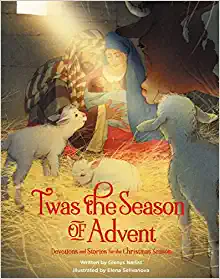
During the busy holiday season, this collection of daily readings could be just the reminder children need to pause and reflect on why we celebrate Christmas. Each day from the first of December through Christmas contains a different theme relating to a Bible verse. The format is consistent, beginning with a rhyming poem (loosely based on the classic 'Twas the Night Before Christmas), a verse, a narrative, and a suggested prayer. The content for each date usually fits on one page and is accompanied by a beautiful full-page illustration depicting an aspect of the message. Verses are chosen from seven different books of the Bible, both Old and New Testament. Some themes are: all are welcome, love, promise, bravery, joy, family, nothing is impossible with God, angels, good news, hope, patience, peace, shepherds, and magi. Nellist teaches readers that the season of Christmas is just the beginning, and a greater story could be continued in the days beyond. The content is concise, and a leader or parent could share this collection without advance preparation. The narratives are typically four to six paragraphs in length. Elementary students would likely find the narratives interesting, and this may lead to questions while they ponder the message.
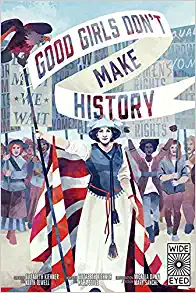
Understanding the barriers that people have overcome in order to vote is vital for maintaining American democracy. The book opens with the juxtaposition of teenage Ava, who waits with her mom in line to vote in present-day California and, in 1840, Elizabeth Cady Stanton being ejected from the World Anti-Slavery Convention in England because she's a woman. In the next chapter, three new adult women in the present-day at Middlehurst College register to vote and discuss the Iroquois influence on the suffragist movement, and, in 1907 New York, Inez Milholland and Harriet Stanton found the Equality League of Self-Supporting Women. By showcasing the history of American women's suffrage from 1840 to 1920 and balancing contemporary fictional characters with real historical figures like Lucretia Mott and Ida B. Wells, this graphic novel argues the importance of women's suffrage and the continuing need to defend and preserve the right to vote all Americans have. The inclusion of competing ideologies within the suffragist movement adds nuance to the often broadly painted topic of women's suffrage. Highlighting marginalized voices elaborates on the struggles women once and still face when voting while promoting intersectional feminism. Realistic illustrations and a pervading patriotic color scheme of red, white, and blue ground this story in American history, though the flat style stilts what should be dynamic moments and lessens the literal impact of the violence some suffragists suffered. Every new segment notes the date and key figures, but more often than not, the present leaves out the year and the constant reintroduction of the main cast toes the line between helpful and exasperating. Even with these minor hitches, this work makes a genuine, educational, and relevant case for the power of and need for fair voting that will enfranchise young adults to participate in their own government.

Brooklyn's own friendly neighborhood Spider-Man has the answers to the most pressing questions about his new life as a superhero. He's heard them all before, and he revels in the curiosity and excitement that surrounds him when he dons his bug-eyed mask and black, skin-tight bodysuit, or when he travels through the city, all too recognizable as he swings between building tops and shoots his webs with sweeping ease. He answers them as best he can while simultaneously fighting crime and taking pictures with starstruck fans. Spider-Man, working in tandem with an appreciative police force, seems to have it all under control--until he doesn't. Thankfully his best friend and tech genius Ganke keeps him grounded. He manages to separate his supernatural life from his everyday life until they collide in an unexpected way. In this graphic novel, Spider-Man gets his hands on a highly coveted mysterious rock belonging to mega company Serval Industries. Now Miles and Ganke must join forces with new student Kyle, whose father has suddenly gone missing, to unshroud the mystery surrounding the rock and the company. Readers see Spider-Man spring into action to uncover the truth about the rock and Kyle's missing father. All the while, Miles Morales, the kid behind the mask, must wrestle with shocking news about an earthquake in Puerto Rico and the devastation it causes to his mother's family home. Spider-Man leans on his supernatural powers to help save the day, while Miles puts his hopes in spearheading a fundraiser to help his mother's home country. Readers will see themselves in Miles' every attempt to be his best self, supernatural powers or not. Reynolds creates a relatable protagonist who wants equally to learn the new Internet dance craze and to accurately trap bad guys with the spray of his web. Leon's bold illustrations capture Spider-Man's every flight and pensive repose on the side of a building with a precision that brings his cool superpowers to life. Though there is a delicate balancing act between Spider-Man's crime-fighting life and Miles Morales' extraordinary life, this story webs a connection between the two with an unexpected plot twist. Young readers will enjoy the action and mystery. Teachers will find this engaging graphic novel, and its spotlight on diverse perspectives, a welcome addition to their libraries.
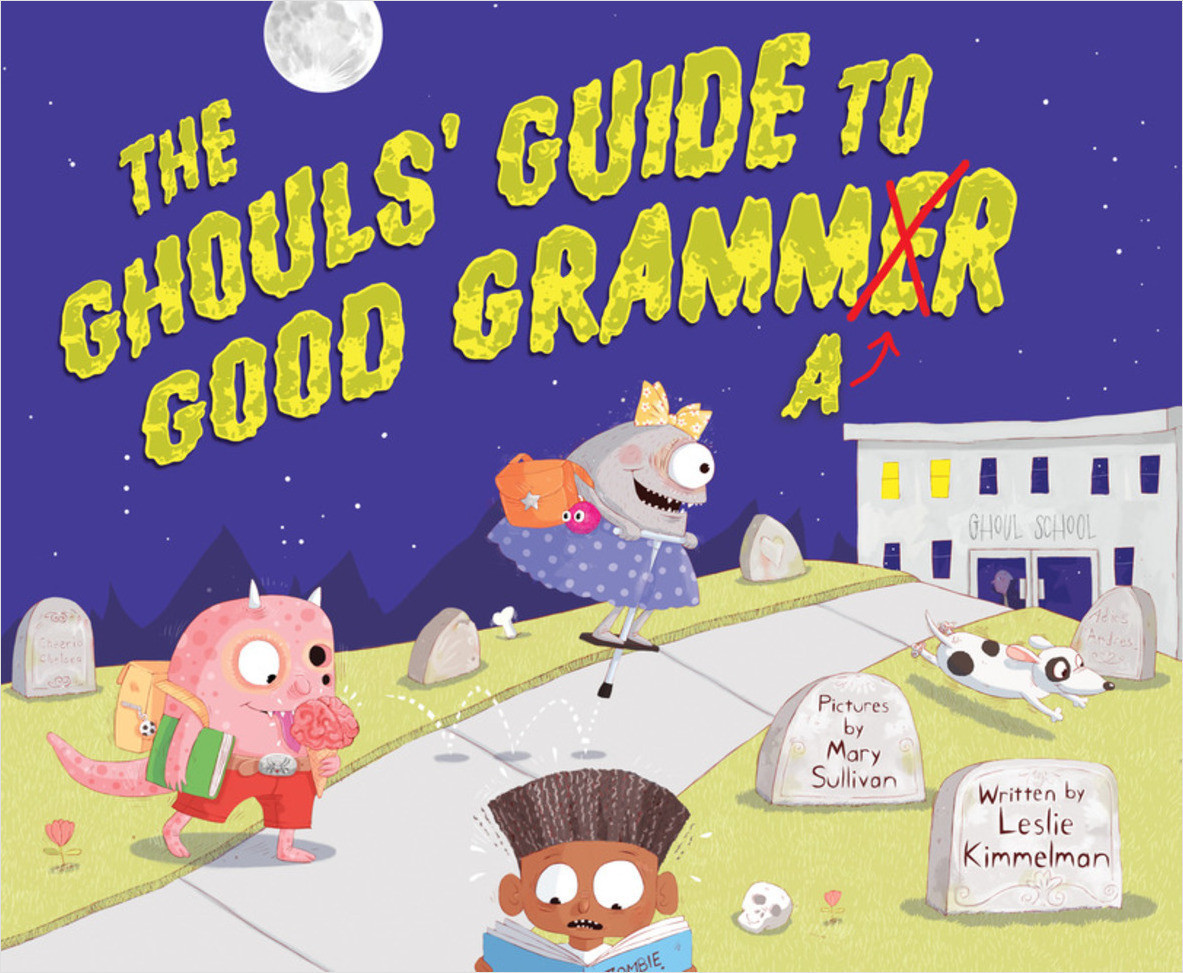
What could be more fun than studying grammar with ghouls? Kimmerman brings the rules of punctuation to life through this innovative book, filled with Sullivan's charming illustrations. Readers will discover the ins and outs of everything from hyphens to misspellings. It's hard not to laugh over a period that gives you time to pick your nose, or a vampire as the subject of an exclamation: "Oh no! The grave is empty! Grandpa's escaped again!" Readers will quickly understand that comma placement is critical in the sentence, "Vanessa Vampire loves cooking, her parents, and her baby sister." With humor and a fun approach, this brings a difficult subject to life. With every turn of the page, young readers will learn more about grammar while meeting new ghouls and monsters. This book is guaranteed to entertain grammar fans and monster-lovers of all ages.
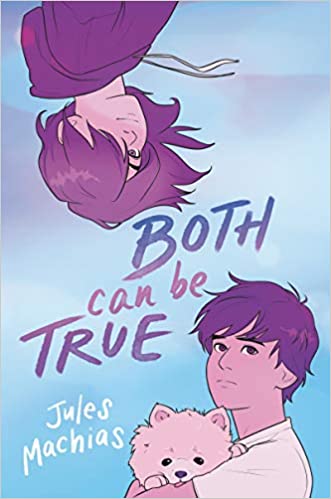
Machias delivers a book that could save someone's life, a young adult novel that some readers have been searching for. The story is told in alternating chapters by Ash and Daniel. Both characters are dealing with very relatable and realistic personal, social, and family issues. Ash's story opens with a debate over which bathroom to use at a new school. Forced to decide but still feeling extremely conflicted about the choice, Ash and best friend Griffey head to the school's Rainbow Alliance meeting, which gives ample food for thought. Meanwhile, Daniel is volunteering at a veterinarian's office. He is suddenly involved in a difficult situation to save a dog's life, which requires him to spin a web of lies. As the story progresses, Ash begins helping Daniel care for the dog, but neither character is completely honest with the other about their feelings, emotions, and personal situations. As each character's situation becomes more complex, the web of lies starts to unravel. Eventually, both characters reach a point where they must stand up for who they are, despite resistance from their own feelings and some family members. Machias manages to confront gender conformity, gender bias, identity, bullies, divorce, friendship, truth, and acceptance through the characters.

Poorling is a most unbear-like little bear. She looks very different from her brothers and very different from her mother. Right away, readers have many questions: Who is this bear? Why does she look the way she does? How does she relate to her family members? Each turn of the page seems to raise more questions as the story evolves and our understanding of each character's role is transformed. This is a magical tale, delivered in a visually wondrous combination of black-and-white and watercolor washes. At 400 pages, it is quite a tome compared to other graphic novels, but its heft is appropriate: This is not a story to be raced through, but one to dwell over. A word of caution: Like other origin stories, this includes some violence. Presented in this visual format, young readers may find these scenes jarring. Still, Finnish author Ahokoivu's work is a flowing story that captivates the imagination. A truly unique offering to be added to any graphic novels collection
The Malka Penn Award for Human Rights in Children's Literature
The Malka Penn Award https://humanrights.uconn.edu/awards/malka-penn-award/# is given annually to the author of an outstanding children's book addressing human rights issues or themes such as discrimination, equity, poverty, justice, war, peace, slavery, or freedom. The award recognizes works of fiction, non-fiction, poetry, memoir, or biography written for children from preschool to high school. Books about characters facing and affected by social injustices are frequently recognized. The award is named in honor of Michele Palmer (pseudonym Malka Penn) and is presented by Dodd Human Rights Impact at UConn. For a list of past winners, visit https://humanrights.uconn.edu/awards/malka-penn-award/past-award-recipients/.
2021 Malka Penn Award Winner
This is My America by Kim Johnson
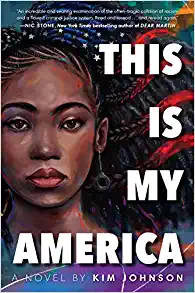
Every week, seventeen-year-old Tracy Beaumont writes letters to Innocence X, asking the organization to help her father, an innocent black man on death row. After seven years, Tracy is running out of time--her dad has only 267 days left. Then the unthinkable happens. The police arrive in the night, and Tracy's older brother, Jamal, goes from being a bright, promising track star to a "thug" on the run, accused of killing a white girl. Determined to save her brother, Tracy investigates what really happened between Jamal and Angela down at the Pike. But will Tracy and her family survive the uncovering of the skeletons of their Texas town's racist history that still haunt the present?
2019 Malka Penn Award Winner
The White Rose by Kip Wilson

Based on the incredible story of Sophie Scholl, a young German college student who challenged the Nazi regime during World War II as part of The White Rose, a non-violent resistance group. Disillusioned by the propaganda of Nazi Germany, Sophie Scholl, her brother, and his fellow soldiers formed the White Rose, a group that wrote and distributed anonymous letters criticizing the Nazi regime and calling for action from their fellow German citizens. The following year, Sophie and her brother were arrested for treason and interrogated for information about their collaborators. This debut novel recounts the lives of Sophie and her friends and highlights their brave stand against fascism in Nazi Germany.
2018 Malka Penn Award Winner
The Night Diary by Veera Hiranandani

It's 1947, and India, newly independent of British rule, has been separated into two countries: Pakistan and India. The divide has created much tension between Hindus and Muslims, and hundreds of thousands are killed crossing borders. Her deceased mother was Muslim, her father is Hindu. Half-Muslim, half-Hindu twelve-year-old Nisha doesn't know where she belongs or what her country is anymore. When Papa decides it's too dangerous to stay in what is now Pakistan, Nisha and her family become refugees and embark first by train but later on foot to reach her new home. The journey is long, difficult, and dangerous, and after losing her mother as a baby, Nisha can't imagine losing her homeland, too. But even if her country has been ripped apart, Nisha still believes in the possibility of putting herself back together. Told through Nisha's letters to her mother, The Night Diary is a heartfelt story of one girl's search for home, for her own identity...and for a hopeful future.
2017 Malka Penn Award Winner
My Beautiful Birds by Suzanne Del Rizzo
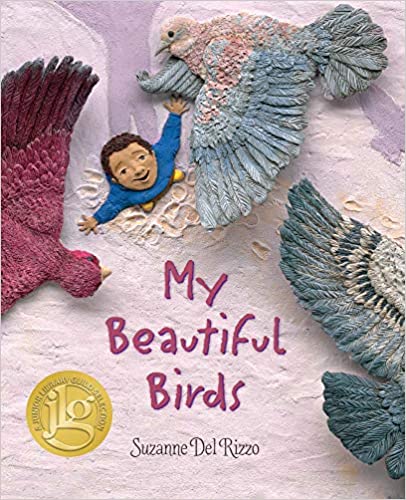
Behind Sami, the Syrian skyline is full of smoke. The boy follows his family and all his neighbors in a long line as they trudge through the sands and hills to escape the bombs that have destroyed their homes. But all Sami can think of is his pet pigeons—will they escape too? When they reach a refugee camp and are safe at last, everyone settles into the tent city. But though the children start to play and go to school again, Sami can't join in. When he is given paper and paint, all he can do is smear his painting with black. He can't forget his birds and what his family has left behind. One day a canary, a dove, and a rose finch fly into the camp. They flutter around Sami and settle on his outstretched arms. For Sami, it is one step in a long healing process at last.
